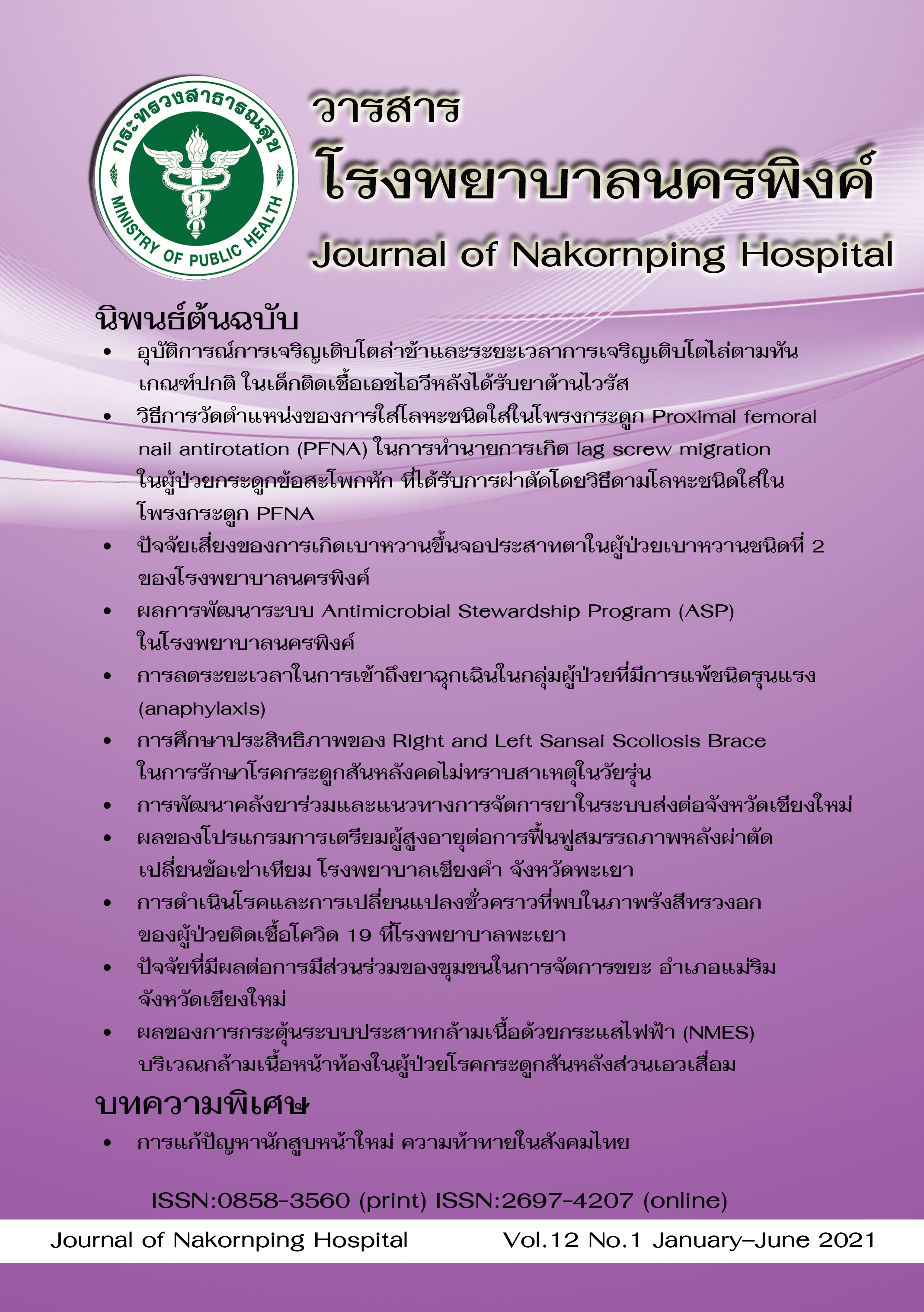Solutions to Prevent New Smokers: The Challenge of Thai Society
Keywords:
New smokers, tobacco control, challengeAbstract
The rate of cigarette smoking is increasing consecutively among adolescents and they start smoking at an earlier age because of their misconception, unaware of the dangers of cigarettes, as well as assistance from personnel in healthcare teams are discontinued, inconsistent, and do not meet demands. Healthcare teams and persons who are engaged with them must have knowledge and understanding of adolescent development as well as the dangers of cigarette smoking. Therefore, it is considered that they play a vital role to prevent teenage smoking via a campaign that promotes; protection, treatment, rehabilitation, and prevention. Framework Convention on Tobacco Control (FCTC) was launched by the World Health Organization to be implemented as tobacco control in each country. The implementation of tobacco control in Thailand has been recognized globally, especially tobacco control laws which are known as the best regulation and most admired in the world. However, new smokers persistently emerge, particularly new, youth-aged smokers. Research on smoking behavior in B.E. 2560 revealed that the Thai population started smoking cigarettes at the age of 18-19 and the average age of cigarette smoking initiation was 16 years old. Determinants of new, youth smokers have multiple factors, i.e., the individual, friends, family, and the social environment around the individual. This article aims to propose guidelines to prevent new, youth smokers. Thai society has to change at each level to prevent new youth smokers. These changes should include from at the policy, law and regulations level, at the societal and cultural level to at the individual level to prevent new smokers. These changes are very challenging for Thailand, yet it is possible and hope that these can sustainably prevent the rise of new smokers.
References
สำนักควบคุมบริโภคยาสูบ. แผนยุทธศาสตร์การควบคุมยาสูบแห่งชาติ พ.ศ. 2559-2562. นนทบุรี: ไนซ์เอิร์ธ ดีไซน์; 2559.
ศิริวรรณ พิทยรังสฤษฏ์, ปานทิพย์ โชติเบญจมาภรณ์, ปวีณา ปั้นกระจ่าง, บรรณาธิการ. สถานการณ์การควบคุมการบริโภคยาสูบของประเทศไทย พ.ศ. 2559. กรุงเทพฯ: เจริญดีมั่นคงการพิมพ์; 2559.
กรองจิต วาทีสาธกกิจ. คู่มือการรักษาโรคเสพติดยาสูบสำหรับพยาบาล. กรุงเทพฯ: มณปรียา กราฟฟิค; 2559.
Tomkins SS. Psychological model for smoking behavior. Am J Public Health Nations Health. 1966;56(12):17-20.
ประภาพร นันทการัตน์. การศึกษาพฤติกรรมการสูบบุหรี่ของนักศึกษามหาวิทยาลัยเทคโนโลยีราชมงคลกรุงเทพ [รายงานการวิจัย]. กรุงเทพฯ: มหาวิทยาลัยเทคโนโลยีราชมงคลกรุงเทพ; 2552.
HealthLinkBC. The Harmful Effects of Second-hand Smoke [Internet]. British Columbia: HealthLinkBC; c2021 [Update 2019 May]. Available from: https://www.healthlinkbc.ca/healthlinkbc-files/second-hand-smoke
MGR Online. ควันบุหรี่มือสาม...อันตรายกว่าที่คิด (Infographic) [อินเทอร์เน็ต]. กรุงเทพฯ: MGR Online; c2014-2021 [เข้าถึงเมื่อ 1 มกราคม 2564]. เข้าถึงได้จาก: https://mgronline.com/qol/detail/9560000088999
World Health Organization. WHO report on the global tobacco epidemic 2017 Monitoring tobacco use and prevention policies [Internet]. Switzerland: World Health Organization; 2017. Available from: http://apps.who.int/iris/bitstream/handle/10665/255874/9789241512824-eng.pdf;jsessionid=138B7C18E6301D83171578A50B47F425?sequence=1
สํานักงานสถิติแห่งชาติ. การสำรวจพฤติกรรมการสูบบุหรี่และการดื่มสุรา พ.ศ. 2557. กรุงเทพฯ: เท็กซ์แอนด์เจอร์นัล พับลิเคชั่น; 2557.
World Health Organization. Intimidation: Stop tobacco industry interference. Geneva: World Health Organization; 2012.
Khasabai S, Thiraluk P, Mothana N, Preejumrus N, Thinmuang T, Kengganpanich M. Effect of School Based Health Education Activities for New Smoker’s Protection. Thai Journal of Health Education. 2015;38(3):54-64.
Pittayarangsarit S, Pankrachang P, editors. Thailand Tobacco Consumption Statistics Report 2018. Bangkok: Careindeemungkong Publishing; 2018.
Pittayarangsarit S, Pankrachang P, Sitabut D, editors. Summary of 25 years: Tobacco Consumption Control in Thailand 1992 - 2017. Bangkok: Careindeemungkong Publishing; 2017.
Bureau of Tobacco Control. Tobacco consumption international survey. Nonthaburi: Bureau of Tobacco Control; 2015.
World Health Organization. WHO Framework Convention on Tobacco Control [Internet]. Switzerland: World Health Organization; 2005. Available from: http://apps.who.int/iris/bitstream/handle/10665/42811/9241591013.pdf?sequence=1
Tobacco Control Research and Knowledge Management Center. Fact document about the new tobacco product control act of legislation. Bangkok: Tobacco Control Research and Knowledge Management Center; 2015.
Prutipinyo C. Comprehensive Tobacco Control Laws and Policies. Public Health & Health Laws Journal. 2015;1(3):254-71.
จักรพันธ์ เพ็ชรภูมิ, ปิยะรัตน์ นิ่มพิทักษ์พงศ์. การทบทวนวรรณกรรมเรื่องมาตรการจำกัดการเข้าถึงบุหรี่ของเยาวชน. วารสารสาธารณสุขศาสตร์. 2558;45(3):310-23.
Diemert L, Dubray J, Babayan A, Schwartz R. Strategies Affecting Tobacco Vendor Compliance with Youth Access Laws: A Review of the Literature. Toronto: Ontario Tobacco Research Unit; 2013.
DiFranza JR, Rigotti NA. Impediments to the enforcement of youth access laws. Tobacco Control. 1999;8(2):152-55.
Miura M, Berman M, Dodds W. Tobacco Retail Licensing: Local Regulation of the Number, Location, and Type of Tobacco Retail Establishments in New York [Internet]. Boston: The Center for Public Health & Tobacco Policy; 2010 [cited 2021 Feb 9]. Available from: https://publichealthlawcenter.org/sites/default/files/resources/nycenter-syn-retaillicensing-s010.pdf
Glanz K, Jarrette AD, Wilson EA, O'Riordan DL, Jacob Arriola KR. Reducing minors' access to tobacco: eight years' experience in Hawaii. Prev Med. 2007;44(1):55-8.
Landrine H, Klonoff EA, Alcaraz R. Asking age and identification may decrease minors' access to tobacco. Prev Med. 1996;25(3):301-6.
DiFranza JR. Best practices for enforcing state laws prohibiting the sale of tobacco to minors. J Public Health Manag Pract. 2005;11(6):559-65.
Simcoe County District Health Unit. Reducing Youth Access and Supply to Tobacco in Simcoe County and Peterborough [Internet]. Barrie, ON: Simcoe County District Health Unit; c2001 [cited 2021 Jan 2]. Available from: https://www.ptcccfc.on.ca/common/pages/UserFile.aspx?fileId=114495
Tools of Change. Reward and Reminder Reduces Illegal Cigarette Sales [Internet]. Canada: Tools of Change; c1996-2021 [cited 2021 Jan 2]. Available from: http://www.toolsofchange.com/en/casestudies/detail/630
Altman DG, Wheelis AY, McFarlane M, Lee H, Fortmann SP. The relationship between tobacco access and use among adolescents: a four community study. Soc Sci Med. 1999;48(6):759-75.
Downloads
Published
How to Cite
Issue
Section
License
The articles that had been published in the journal is copyright of Journal of Nakornping hospital, Chiang Mai.
Contents and comments in the articles in Journal of Nakornping hospital are at owner’s responsibilities that editor team may not totally agree with.



